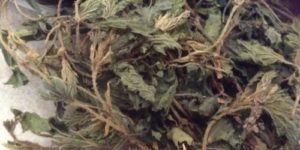Rhubarb Bread
I like to make quick breads for my family to eat with their meals. One of the most popular is banana bread. I also shred and freeze zucchini in the fall for making zucchini bread throughout the winter. I don’t like to feel trapped with making the same breads over and over, so I set out to find something new.
I was quite specific in my searching because my rhubarb is starting to come up, and I wanted to use up some frozen rhubarb from last season. I found a few different rhubarb quick bread recipes, but I finally settled on one that had a lower amount of sugar and all the ingredients I already had on hand.
I always substitute honey or syrup for the sugar in quick breads. I also cut down on the sweetener used because most quick breads just don’t need a high amount of sugar to still taste good. I was a little nervous doing this with rhubarb because it is so tart, but the bread turned out delicious!
You will need to puree some rhubarb for this recipe.
Rhubarb Puree
1 cup rhubarb, chopped
1/4 cup water
Combine the rhubarb and water in a small pot and bring to a boil. Reduce heat and simmer for about 10 minutes or until rhubarb falls apart into a thick sauce. Remove from heat and let cool.
Rhubarb Bread
Dry Ingredients:
1/2 cup walnuts
1 1/2 cups flour
1/2 teaspoon baking soda
1/4 teaspoon salt
1/4 teaspoon nutmeg
1/2 teaspoon cinnamon
Wet Ingredients:
1/2 cup syrup (if using dry sweetener, combine with dry ingredients)
1 Tablespoon lemon zest
2 eggs
1 cup rhubarb puree
1/2 cup oil
1/2 cup rhubarb, chopped (fresh or frozen)
Heat oven to 350 degrees. Grease bottom of loaf pan.
Combine all dry ingredients and mix together.
Combine wet ingredients and add to dry mix. Stir to combine.
Stir in chopped rhubarb.
Pour batter into loaf pan, and bake for about 1 hour.
Remove pan to wire rack and let cool 10-15 minutes before removing bread.
Remove bread from pan and let cool on wire rack.
Slice and enjoy!

